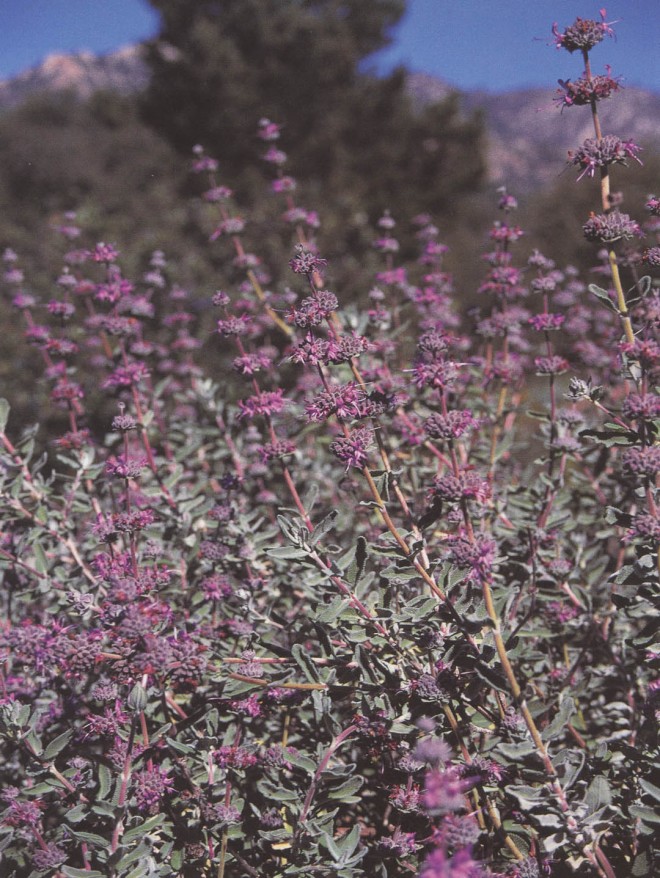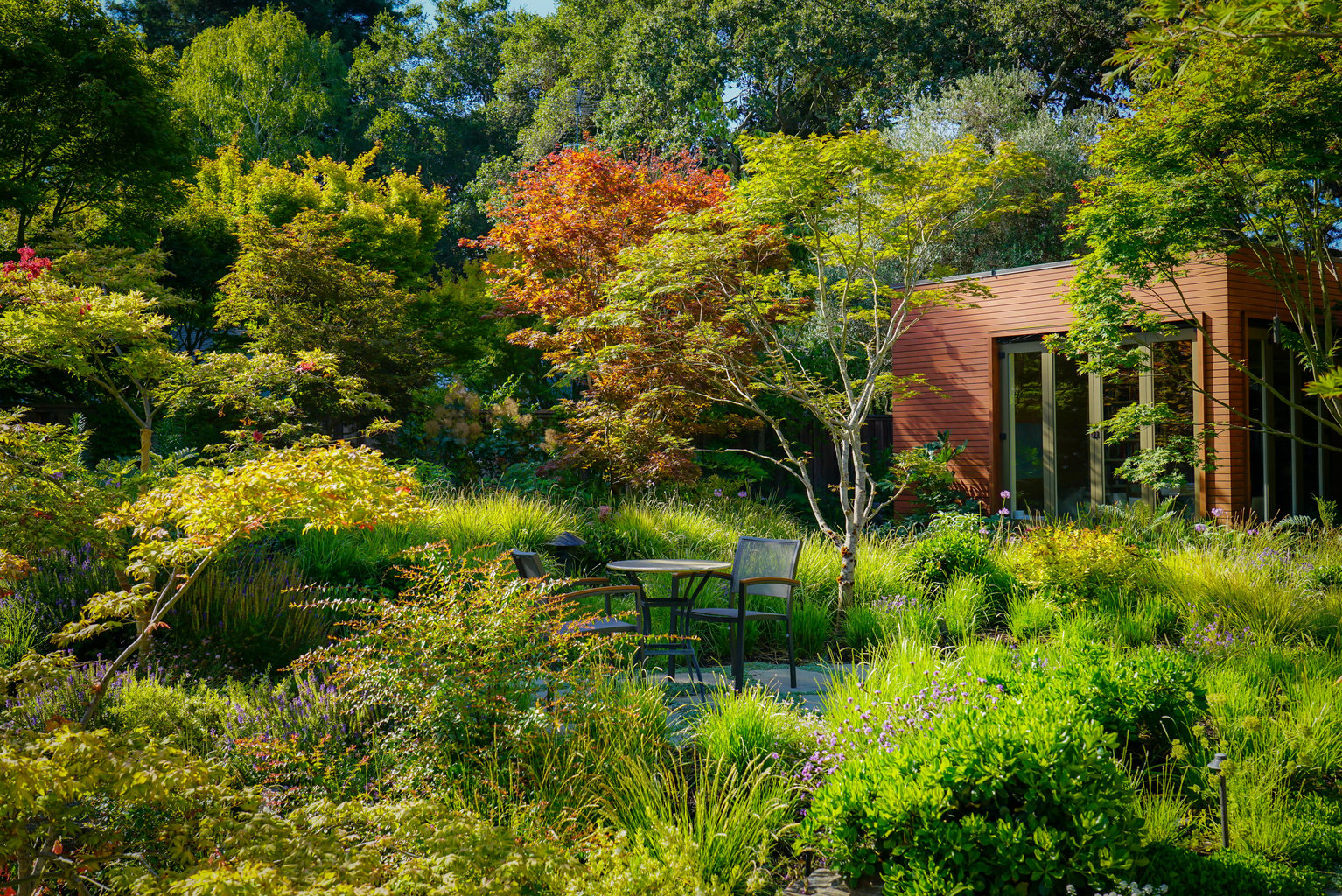
A New Sage: ‘Amethyst Buff’

Contributor
- Topics: Plants You Need, Sustainable Gardening
“Look!” said one, pointing to the west. “A rider!”… a horseman, silhouetted against the western sky, coming riding out of the sage.
Zane Grey, Riders of the Purple Sage, 1912
The flowers come from thick whorls of calyces spaced up the stems and are soft strawberry-pink, or lavender-pink, or dark purple, or just plain pink—not a great many out at a time but enough to make the bush attractive.
Lester Rowntree, Flowering Shrubs of California, 1947
Riders (admirers, that is) of purple sage (Salvia leucophylla ), take note. Literary references aside, there’s a new cultivar called ‘Amethyst Bluff’ that is worth trying in your garden. The Santa Barbara Botanic Garden is pleased to add this plant to the expanding list of exceptional California natives for water-thrifty landscapes.

At a time when planting natives was unfashionable, Lester Rowntree encouraged California gardeners to cultivate them, including purple sage. Its pale pink to purple flowers (from late winter to early summer) and its aromatic, silvery gray foliage combine equally well with both pastel and warm colors in the dry garden. The long inflorescences hold up admirably in flower arrangements and provide copious nectar for hummingbirds and pollen for bees. Salvia leucophylla is one of the more adaptable native sages in that it tolerates fairly heavy clay soils and occasional out-of-season watering during the summer. It also performs a valuable function in controlling erosion on hillsides, not surprising when one sees it clothing steep slopes in the wild. It is not, however, reliably cold tolerant.
Purple sage is a common component of the coastal sage scrub and chaparral plant communities below 2,000 feet elevation in the coastal and interior mountains of Central and Southern California. Typically a three- to six-foot upright shrub, the wind-swept population at Pt Sal in northern Santa Barbara County hugs the ground in decumbent mounds. It is from these coastal bluffs that several selections of purple sage (‘Pt Sal’, ‘Pt Sal Spreader’, and ‘Tilden Prostrate’) have been made by discriminating botanists and horticulturists. All possess a mounding form and have performed well at the Santa Barbara Botanic Garden. They are less successful in inland situations, such as at Rancho Santa Ana Botanic Garden.
What distinguishes ‘Amethyst Bluff’ from these other fine cultivars is its flower color, size, and shape. It was the color that caught my eye many years ago as I explored the vegetation of Pt Sal one early spring day. The vivid purplish pink blossoms, along with the purple-tinged peduncles, stood out among the sea of purple sages carpeting the slopes 150 feet above the beach.
The parent plant was two feet tall and four feet across, yet in cultivation at SBBG (at 700 feet in the foothills of the Santa Ynez Mountains and several miles from the ocean) it becomes decidedly more upright, reaching four to five feet in height. As with the aforementioned cultivars, ‘Amethyst Bluff’ is perhaps capable of unlimited lateral growth; all exhibit occasional rooting of the decumbent branches. Our oldest specimen (over nine years old) is eighteen feet across and continues to spread in several directions. Were it not at the edge of a path, it would undoubtedly be even wider. Not a good candidate for small gardens!
We have used ‘Amethyst Bluff’ as a gray accent in our perennial borders, in large drifts, and on gentle slopes. It is particularly effective in front of the dark green foliage of tall ceanothus, such as ‘Sierra Blue’, with drifts of seaside daisy (Erigeron glaucus), low-growing buckwheats (Eriogonum spp.) or manzanitas (Arctostaphylos spp.), golden yarrow (Eriophyllum confertiflorum), fine-textured bunchgrasses, and Lessingia ‘Silver Carpet’ in the foreground. One word of caution about this and other purple sages: they all tend to look a bit tired when the long, hot days of summer arrive. The older leaves drop off, the younger ones shrink in size, and the ashy gray flower stalks hang on tenaciously as the plant patiently rests until the autumn rains return. Prune away the stalks and give it a monthly soaking, if a more manicured and vibrant look is desired.
The Santa Barbara Botanic Garden was encouraged to name this selection by the evaluation team for our plant introduction program (see Pacific Horticulture, Winter ’98). A few wholesale nurseries have already begun to propagate ‘Amethyst Bluff’, so expect to see it in catalogs, retail nurseries, and at botanic garden plant sales in the near future. [A small number of plants were sold at the garden’s recent fall plant sale.] As with other recent SBBG introductions, a modest royalty for each commercially grown plant will enable the garden to continue selecting promising new natives for California gardens.
Share:
Social Media
Garden Futurist Podcast
Most Popular
Videos
Topics
Related Posts

Low Maintenance Gardens – Better for Pollinators and People
Autumn 2022 “I come out every day. It’s therapy, my meditation.” Janet’s young garden transformed from overgrown, invasive plants to mostly natives. The dailiness of

Invasive Plants Are Still Being Sold: Preventing Noxious Weeds in Your Landscape
Autumn 2022 With so many beautiful ornamental plant species and cultivars throughout California and the Pacific Northwest, how do you decide which ones to include

Garden Design in Steppe with Transforming Landscapes with Garden Futurist Emmanuel Didier
Summer 2022 Listen to full Garden Futurist: Episode XVII podcast here. Emmanuel Didier, Principal and Creative Director at Didier Design Studio is a leading figure

Seslerias: Versatile Groundcover Meadow Grasses
Summer 2022 Without question, the most beautiful and versatile of all the groundcover meadow grasses are the moor grasses (Sesleria). Moor grasses tick off all










Responses